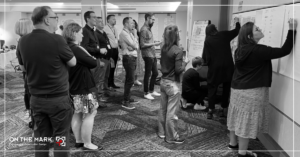5 Minute Read
Takeaway: The decision-making process is arguably the most important factor in determining the success of the decision. Executives must understand the current state of a situation, set a direction for problem-solving, uncover multiple options and innovative ideas, evaluate ideas, and implement the preferred idea – all while remaining aligned and aware of the impact that the organization’s culture has on the process…
Executive decisions are important choices that commit an organization to courses of action with long-term consequences.
These decisions always concern problems to solve and variably concern customers, markets, channels, competitive advantage, competencies, alliances, sources of revenue, ways to organize, company image, etc. Ambiguity, uncertainty, conflict, and risk are all present. While such decisions culminate in some dramatic “go/no-go” moment, the decision-making context and process that lead to these moments is critical.
Context and process are critical because the environment is complex and significant decisions require commitment from the organization. Executives must therefore unlearn the role of leader as an individualized decision-maker. With a broader orientation, executives are 50% more likely to lead an organization to decisions that are both well informed and effective.
Decision-Making Styles
Decision-making exists within organizational culture. Culture is shaped by a set of assumptions, orientations, and values. These influence member expectations about leader behavior and the decision-making process. Executives who are aware of this impact will find more success if their decision processes align with member expectations.
Culture almost always aligns with one of four dominant styles, each having a corresponding theory of effectiveness:
-
Collaborative | Human development and participation
-
Creative | Innovation, vision, and new resources
-
Controlling | Control with capable processes
-
Competing | Aggressive competition inside and outside the organization
Managerial Decision-Making
Any given leadership and decision-making style will have varying degrees of harmony or dissonance with established cultural expectations. Furthermore, organizations of any size have dominant cultures and subcultures. Here’s a good example: part of an organization asked to be radically innovative and growth-oriented. This part of the organization operates within a collaborative, slower-growth culture. It is likely that leadership and decision-making suitable for the innovation boundary will clash with the broader culture.
Effective managerial decision-making begins with the awareness that organization culture influences effective decision-making processes.
Executive Decisions
Executives must be aligned in critical decisions. A management operating system (MOS) provides the critical structure for alignment and executive decision-making. It includes agreements about mechanisms that will integrate the leadership team and policy about the management of control (risk avoidance) versus autonomy (risk tolerance). Executive decision-making is both facilitated and restrained by these design choices. These components are complementary to one another:
- Policy Agreements – These agreements essentially set boundaries of discretion for leadership decision-making. Inside these boundaries, a leader is empowered to make choices and set direction within their unit of service. Boundary cases or areas that are clearly outside the boundary require focused discussion within the leadership team. The purpose is to help ensure leadership decisions are informed by a complete system view. This avoids the sub-optimization of the whole organization while leaders attempt to optimize their scope of responsibility.
- Integrating Mechanism – The integrating mechanism ensures cohesion among senior leaders where the common pattern tends to be fragmentation of responsibility, territorialism, and turf battles. The integrating mechanism offers a dedicated time and place to discuss leadership decisions that fall outside the boundaries of discretion described above. It requires integration among leaders who may not naturally invite others into their domain of responsibility. An additional feature of this mechanism is the creation of a time and place to deliberate matters that are important but not urgent. This is often the domain of executive decision-making.
Decision-Making Approaches
Processes are the most important determinant for decision-making success. This topic spans a range from team-level decision methods to much larger-scope, multi-stage decision-making process. In each, the role of the leader is to ensure deliberate consideration of the best executive decision-making method/process for the task. In many cases, there is no explicit consideration and agreement for how a decision will be made.
Team-level decision-making methods generally align to one of six options:
- One person makes the decision and thinks alone. Useful when there is single accountability or when one individual is the expert.
- One person makes the decision with input from others. Useful when additional knowledge or expertise is required.
- Subject matter expertise or issue falls primarily in their scope of responsibility or influence. Useful when one group has single accountability or has unique expertise.
- The group makes decisions via a vote. Useful when there are clear options.
- All participants have the same power, anyone can block, and all must support the decision. Useful when the decision impacts the entire group.
- All agree and support. Useful when total commitment is necessary.

Executive Decision-Making Process
These methods are useful but the process that generates information and options on which decisions are made is a much bigger topic. The concern of process is how an organization will engage in a series of activities to collect information and reveal possibilities. Here, there are proven practices that increase the probability of decision success by up to 50%. Effective practices include:
-
Understand the current state of a situation.
-
Set a direction for problem solving.
-
Uncover multiple options and innovative ideas.
-
Evaluate ideas.
-
Implement the preferred idea.
There is nothing magic about these steps. Many will recognize it as a basic problem-solving process. Problems lie in the knowing-doing gap. Many executive decisions unintentionally create trouble by short-circuiting this process. Decision-making traps include poor stakeholder management, premature commitment, the poor use of resources for the purpose of proving a preconceived solution, and various leadership missteps that hinder effective practice.
Make Successful Executive Decisions
Successful executive decision-making doesn’t require leaders to have the answers. It may, however, require unlearning this expectation. It isn’t possible for leaders in today’s environment to have all the answers for their organizations’ most pressing problems. Even if they did, it isn’t enough to drive commitment among those needed to drive an answer into action. Because of this, leaders must rely on process.
How is the totality of this content integrated into the bottom line for effective executive decision-making? First, let go of the idea that you already have the best answer. Second, operate as a coherent leadership team. Third, be very deliberate about your decision-making methods and process, selecting the best one for culture and circumstances. And fourth, whenever possible, use a proven decision-making process and bring multiple perspectives into it.
If you do these things, you can access the collective genius of the organization and avoid the pitfalls of thinking alone.
Dan Schmitz is a Consultant at ON THE MARK. OTM is a global leader in collaborative operating model modernization that creates real change, fast. OTM’s passion for collaborative business transformation is supported by pragmatism, systems thinking, and a belief in people that is unparalleled for 34 years.


